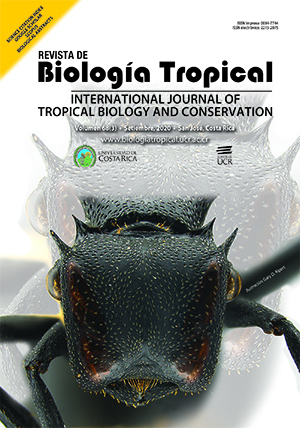Abstract
Introduction: The knowledge about palynology in the Heliconia genus is basically about species from Central and South America, while in Mexican Neotropic species the studies are limited. Objective: to contribute to palynological knowledge and to know the morphological interrelation of pollen between species and within Heliconia genus species originating in Mexico, as part of reproductive biology studies that may contribute in future genetic improvement work. Methods: The study was conducted in nine species (12 accessions) of Heliconia native to Mexico and found in the Germplasm Bank of the National Institute of Agricultural and Livestock Forestry Research (INIFAP). Flower pollen was collected in anthesis and stored for 24 h in 2 % glutaraldehyde and 50% ethanol, then washed in 50% ethanol and dehydrated in 70 %, 90 % and 100 % alcohol for 30 min. The samples were dried at the critical point of the CO2, mounted on aluminum cylinders covered with double adhesive conductive carbon tape and analyzed with a layer of approximately 20 nm gold-palladium. Samples were observed in MEB model TOPCON, SM-510. Results: Pollen measures from 50.22 µm to 70.56 µm, is heteropolar and is euoblate, suboblate or oblate-spheroidal. The distal and proximal faces have different degrees of convexity; both with microechinate or microverrucate ornamentation. The morphological characteristics, pollen shape, shape of the proximal and distal faces, as well as ornamentation, show some homogeneity; however, through the analysis of hierarchical grouping (R2 = 0.05) five groups were formed. Group I has perforate in the tectum, high density of microechinus and high convexity of the proximal face; Group III is represented by H. latispatha and group IV H. librata, both groups are small pollen; however, H. latispatha has a flat proximal face and a germinative pore that is different-protudent, while H. librata has a convex proximal face and both wart faces. In group V, H. collinsiana has a distinct-protudent germinative pore and a ring shape on the proximal face. The two varieties of H. collinsiana differ only by their size (10 µm). Conclusions: Heterogeneity was observed, but also homogeneity in some pollen characters; However, the analysis through clusters allowed us to know the interrelation that exists between and within species. The morphology of the Heliconia species of Mexico conforms to the previously described characters; however, additional features such as the presence of perforate and the ring shape on the proximal face stand out.
##plugins.facebook.comentarios##

This work is licensed under a Creative Commons Attribution 4.0 International License.
Copyright (c) 2020 Simitrio Ortiz Curiel, Guillermo López Guillén, Carlos Hugo Avendaño Arrazate, Misael Martínez Bolaños


